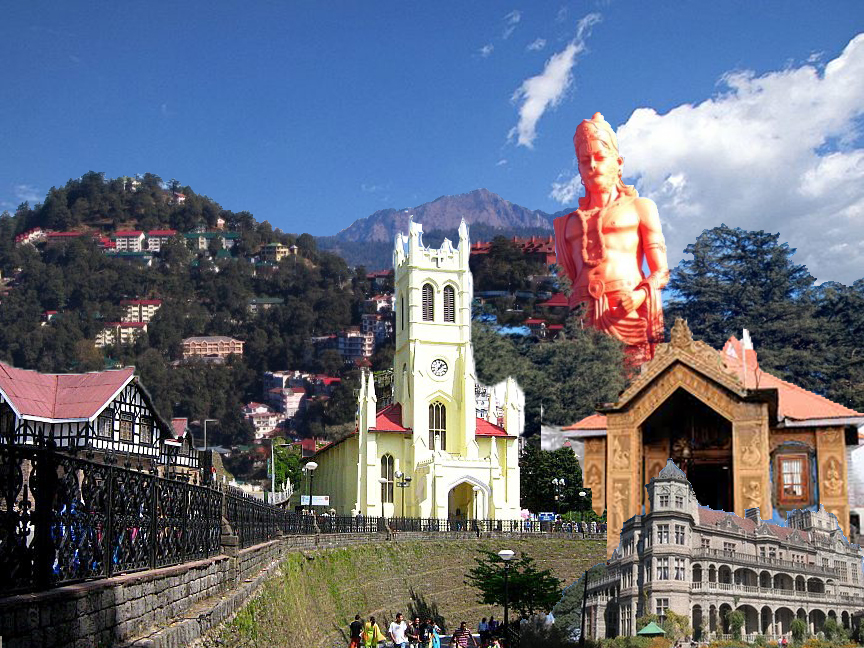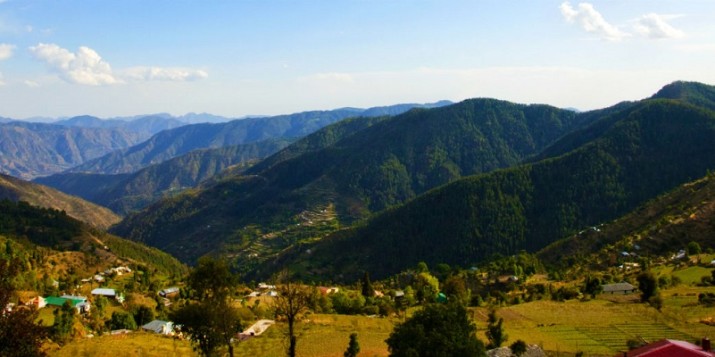Of all the hill stations in India, Shimla (now called Shimla), the capital of Himachal Pradesh, probably has among the highest top-of-mind recall. Situated at an altitude about 2200 metres (7200 ft.) above sea level, and located about 385 km from Delhi, it is easily one of the most popular hill resorts in the country.

Bounded by Mandi and Kullu in the north, and Kinnaur in the east, Shimla was declared as the summer capital of British India In 1864. The climatic conditions had attracted the British to establish the town in the dense forests of the Himalayas. Today, as one would expect, it attracts a large number of tourists.
The omnipresent symbol of Shimla are its Citrus Pines or Deodar trees , with their grand, stately Christmas tree-like shape, stretching as far as the eye can see; enveloping the hillside in a canopy of benign green. That and its sloping green rooftops and the omnipresent, yellow-green railing on the side of the road that seems to skirt most of the town; serving as a barrier to the precipitous fall. One is, in fact, constantly amazed at the expertise of local drivers, as they unerringly make their way across multiple bends and curves; often at considerable speed.

All towns have a place where all roads lead to – the nerve centre where most of the action takes place – and in case of Shimla, it’s the Mall; a common feature in most hill stations up north. Accessed by a lift (two lifts in succession, actually), Shimla’s Mall Road is a line-up of shops that comes alive, late afternoon, as streams of people idly amble past; often with no aim in particular – much like the “passeggiata” in Rome. On weekends, it turns into a bit of a melee, as what looks like half of Delhi (and whole of Chandigarh) descends on it. However, most of the time, it offers the coziest of strolls, past the string of wine shops, dhabas (Punjabi eating joints), dhurrie (rug) sellers, photographers, fast food joints and other establishments.
Nearby, the market place, in a rather endearing throwback into the past, constantly rings out with songs from old Rajendra Kumar films of the 60s – most of which were shot in the vicinity. At the top of Mall Road, near the Ridge and skating rink, lies Scandal Point named so after a certain Maharajah’s wayward scion whisked away a damsel on horseback (if not a damsel in distress), in true Lochinvar style. Years later, sitting there on a misty evening, watching the twinkling lights in the distance, as kids ride on horseback and revellers revel in their newly unwrapped woolens; one feels one could sit there forever.
Shimla is synonymous for its apple orchards. Lovely, large, round golden apples, known as – Golden Apples, what else? – adorn the carts of street vendors, much cheaper than back home. You stock a few into your knapsack, reminding yourself how a price like this would be unthinkable, in the plains below.

They say you don’t really know your way around a place till you’re travelled by bus. The fairly good infrastructure allows one to travel and find one’s way anywhere, even as a newcomer, without shelling out a fortune on cabs. As always, the names sound melodious and sing-song to the ear as you drive past – Sanjauli, Khalini, Bypass and Navbahar, to name some. And of course, there has to be a Summer Hill. Once again, you are reminded of the gentle streak among the locals, who don’t as much as protest or wince, even when you lean your entire frame on them or stomp on a foot or two.
Like several hill resorts, parts of the town are barred for traffic. A good number of heritage buildings punctuate the cozy streets, as you saunter past; including hotels, banks, post offices, government offices, army bases – most in excellent condition, all harking back to a bygone era. Everyone has a favourite spot and mine was a bench on the Vidhan Sabha road (state legislative assembly), overlooking a Deodhar forest on the opposite hills, as the sun set through the thick foliage and hill monkeys foraged for food amidst torn biscuit wrappers – occasionally even walking alongside shoppers and helping themselves (sometimes a bit aggressively) to a fruit or two from their baskets.
For the rustic, robust, ‘pahadis’ (hillsiders or literally, mountain men), accustomed to trudging long distances, directions are usually given through a casual sounding “oos paar” (“that side” or “over there”) – which could be anything up to several miles. For the benefit of the naïve visitor who variably expects the locals to be simple hill folk, selling fruit and wearing old tweed coats and mufflers, Shimla, like most colonial resorts has a well established aristocratic gentry, who know each other closely and often meet (where else?) at the Shimla Club. (The slightly lower-rung hoi polloi converge at the coffee house on the mall, engaging in raucous camaraderie; or simply swapping greetings on the road, clad in coat and tie with an old-world charm, mercifully still alive).

Returning late one night on a dark road, having lost one’s way, one suddenly catches a glimpse of the distant town lights through a pitch-black Deodar forest, creating a memory captured forever in the recesses of the mind; which stays on long after the trip is over.
And so time passes in this timeless paradise, amidst evening strolls on nameless roads, sipping fruit wines under misty night skies; where the biggest decision of the day is whether to go for peach, plum or rhododendron flavour.
Because ‘timeless paradise’ is what Shimla will always be for a lot of people – an adorable town on a maintain top (despite the rampant construction and commercialisation which threaten to ruin it); where temperaments are as sweet as the fruits that grow on its slopes, and distances are still measured in terms of “oos paar.”
The major attractions of Shimla include the Viceroy Lodge, Christ Church, Jhakoo Temple, Mall Road and the Ridge, which together, form the city centre. The Kalka-Shimla Railway line, built by the British, a UNESCO World Heritage Site, is also is also a major attraction. A narrow gauge track, it is listed in the Guiness Book of Records for the steepest rise in altitude, over a distance of 96 km. [The Railway stretches between Shimla and Kalka in the foothills. The special Shivalik Deluxe Express shuttles between the two stations, besides other trains.]
Most of the heritage buildings in the city are preserved in their original ‘Tudorbethan’ architecture. The former Viceregal Lodge (built in 1884–88), which now houses the Indian Institute of Advanced Study and Wildflower Hall, now a luxury hotel, are some of the famous ones. A collection of paintings, jewellery and textiles of the region can be found at the State Museum (built in 1974).
Lakkar Bazaar, a market extending off the Ridge, is famous for souvenirs and crafts made of wood. The hot sulphur springs, or Tatta Pani, believed to have medicinal value, are located on the banks of the River Satluj 55 km (34 miles) from the main city. Shimla’s arts and crafts are in great demand by tourists. They range from excellent pieces of jewellery, embroidered shawls and garments to leather articles and sculptures.
The Shimla Summer Festival, held every year during the peak tourist season and lasting over three to four days, is celebrated on the Ridge. Owing to its steep terrain, the town boasts the mountain biking race, MTB Himalaya, which started in 2005 and is regarded as the biggest event of its kind in South Asia. Shimla also has the only natural ice skating rink in South Asia.
Shimla is well-connected by road network to all major cities in north India. The airport is at Jubbarhatti, 23 km (14 miles) from the city. Currently, there are no regular commercial flights. The nearest major airport and major city is Chandigarh, about 116 km away (three hours by road).
Himachal Tourism website
http://himachaltourism.gov.in/

